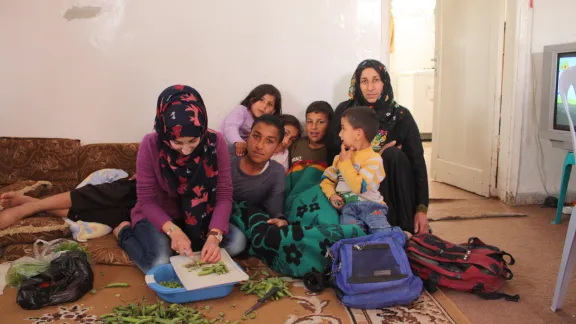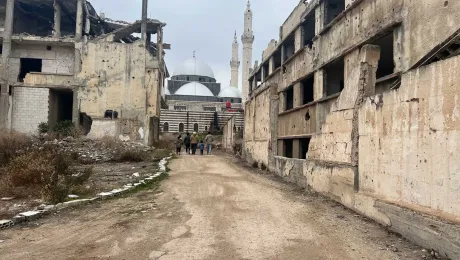
Sabha's family in Mafraq, northern Jordan. Photo: Kristy Bergman-Schroeder/CLWR
By Heather Patterson
Sabha is a Jordanian woman and mother of eight living in Mafraq, northern Jordan, where her family of ten shares a cramped ground-floor apartment. In the hot summer months, the apartment is so crowded that some of the children sleep on the sidewalk in front of the house, next to the street. Her husband is unemployed, and recycles rubbish that he finds in the street's dumpsters.
Moving, however, is not an option. "The prices of everything have increased, and I have loans from sending my daughter to university." Like most parents, Sabha is determined that her children have access to education. She invested heavily in her oldest daughter, who has recently graduated from university with a degree in accounting. Even with loans, the cost of the education was so high that her second daughter was pulled from 10th grade. "We couldn't afford books, the uniform, transportation," Shabha laments. Adding to regular costs is the rent increase that came with the influx of Syrians to the city, doubling rent from JOD 50 to JOD 100 for the small, shabby apartment.
"I just want to see them study and grow, and have their own homes," she says, of her dreams for her children.
The family has little interaction with the Syrian refugees that live in their neighborhood. The boys sometimes play with the neighbors, but the Syrian children are on different shifts in the public schools. "The schools were already full before they came," Sabha says. She believes the population of the city has tripled as a result of the refugees.
"The Syrians, they don't interact with the Jordanians" Sabha says. When asked if she thinks more cohesion should exist she replies "Yes, yes; it's normal. We welcome mixed activities. We are all brothers and sisters" she says, as she moves her fingers parallel to each other to signify similarity.
While population estimates are inexact, the belief of Jordanians in Mafraq that the populations have trebled is a clear indication of the impact on the host community. Though living side by side, many Jordanians and Syrians do not have access to space or activities to build social cohesion by providing safe and interesting opportunities for the groups to meet and mingle. There is a clear need for social integration of the populations, for the purpose of building resilience in the communities as the war inside Syria drags on, with no return home for refugees in sight.
In Jordan, intervention by the LWF emergency program focuses on host communities in the north and at Za’atri refugee camp.
Over 70 percent of Syrian refugees live outside of camps, and tensions between Syrian and Jordanian communities have increased, in particular over scarce resources such as affordable housing, job opportunities, education opportunities and clean water.
In Mafraq, LWF Jordan distributes food vouchers, non-food items, water, sanitation and hygiene materials and constructs classrooms. The “Peace Oasis” project in Za’atri has stepped up its psychosocial support activities with Syrian youth, including the establishment of boys’ football teams, hairdressing courses, computer classes and a reading club.
LWF Jordan has also begun to foster closer collaboration with Islamic Relief Jordan, through designing a joint pilot project, in efforts to strengthen interfaith humanitarian cooperation.
By the end of May, Jordan was hosting nearly 600,000 refugees from Syria. Since the fighting that started in March 2011, over 2.8 million people have fled the country and over 6.5 million have been displaced internally.
Heather Patterson is LWF program officer in Jordan


